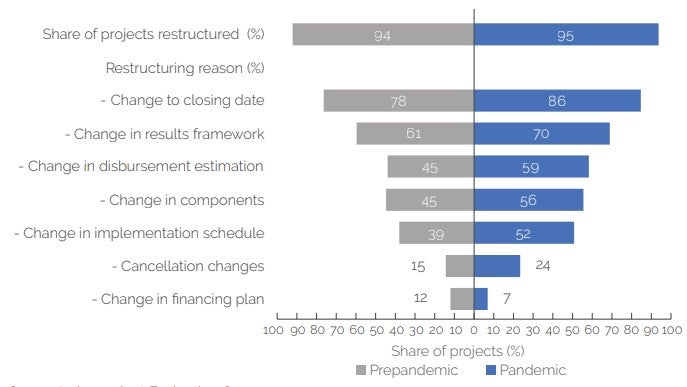World Bank project performance remained resilient and was not undermined despite the more challenging context due to the COVID-19 pandemic and compounded crisis.
Project outcome ratings remained high in fiscal year (FY) 2022, despite many challenges faced during implementation. (Fig. 1)

Fig. 1. World Bank’s Project Outcome Ratings
Projects in the RAP 2023 cohort performed better than those in the prepandemic cohort across all project ratings. (Fig. 2)

Fig. 2. World Bank Project Ratings: Prepandemic Cohort compared with the RAP 2023 Cohort
Part of the reason for improved project ratings for the World Bank is improved monitoring and evaluation frameworks.
The World Bank’s monitoring and evaluation (M&E) quality ratings have consistently improved over time, reaching the highest historical rating of 63% of projects rated substantial or high in FY22. (Fig. 3).

Fig. 3. Monitoring and Evaluation Quality Ratings for Investment
Project Financing and Program-for-Results projects

Fig. 4. Contributions to the Shift in World Bank Project Monitoring and Evaluation Quality Ratings
between Fiscal Year 2021 and 2022: Investment Project Financing and Program-for-Results
Improvements in the World Bank’s monitoring and evaluation quality facilitated project adaptation and contributed to providing sufficient evidence of projects’ results.

Fig. 5. Pearson Correlation Coefficients of Project Ratings in the RAP 2023 Cohort
Improved M&E frameworks helped World Bank projects in making course corrections and respond to unexpected shocks, including those related to the pandemic, in a timely manner.
Increased M&E quality, as reflected in the M&E quality ratings, served as an early warning mechanism that enabled effective adaptive management and provided project teams with a deeper understanding of the progress of projects and the challenges encountered during the implementation of projects.
M&E systems enable teams to adapt to new circumstances by making timely course corrections that are informed by evidence.
Project restructurings in the RAP 2023 cohort occurred more frequently than in the prepandemic period. (Fig. 6)

Fig. 6. Occurrence of and Reasons for Restructuring: The Prepandemic Cohort
Compared with the RAP Cohort
World Bank projects in the RAP 2023 cohort with higher M&E quality ratings had higher efficacy ratings.
This RAP confirms the importance of M&E in improving the performance of projects. It finds that World Bank projects with good-quality M&E tend to have higher efficacy ratings than projects with low-quality M&E.
Efficacy ratings take into account both the validity of the results framework to measure the intended development outcomes and the actual achievement of those outcome measures. M&E frameworks help provide evidence on the achievement of project objectives and targets. (Fig. 7). Project indicators were well aligned with project objectives, and these adequate indicators contributed to improved efficacy ratings.

Fig. 7 . Efficacy and M&E Quality Ratings (Percentage of Projects)
Few projects were rated modest or negligible in efficacy ratings (18%) mainly due to low achievement—that is, a failure to achieve well-defined target indicators, rather than insufficient evidence—that is, a failure to define appropriate results framework indicators (Fig.8).

Fig. 8. Reason for Low Efficacy among Projects Rated Negligible or Modest
Improved M&E frameworks as tools for adaptation and accountability in a postpandemic context.

The World Bank took a proactive approach to adapt and restructure projects as needed during the COVID-19 crisis by closely monitoring projects’ progress and identifying emerging challenges. But, there is a valuable opportunity to scale up project monitoring, adaptation, and restructuring into postpandemic contexts and, more generally, beyond crisis scenarios.
Read the report here. Stay tuned for the next blog as we uncover more insights from the RAP 2023!


















Add new comment